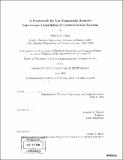| dc.contributor.advisor | Gregory W. Wornell. | en_US |
| dc.contributor.author | Chan, Albert M. (Albert Michael), 1975- | en_US |
| dc.contributor.other | Massachusetts Institute of Technology. Dept. of Electrical Engineering and Computer Science. | en_US |
| dc.date.accessioned | 2005-09-27T16:52:48Z | |
| dc.date.available | 2005-09-27T16:52:48Z | |
| dc.date.copyright | 2004 | en_US |
| dc.date.issued | 2004 | en_US |
| dc.identifier.uri | http://hdl.handle.net/1721.1/28537 | |
| dc.description | Thesis (Ph. D.)--Massachusetts Institute of Technology, Dept. of Electrical Engineering and Computer Science, 2004. | en_US |
| dc.description | Includes bibliographical references (p. 211-215). | en_US |
| dc.description.abstract | Communication over interference channels poses challenges not present for the more traditional additive white Gaussian noise (AWGN) channels. In order to approach the information limits of an interference channel, interference mitigation techniques need to be integrated with channel coding and decoding techniques. This thesis develops such practical schemes when the transmitter has no knowledge of the channel. The interference channel model we use is described by r = Hx + w, where r is the received vector, H is an interference matrix, x is the transmitted vector of data symbols chosen from a finite set, and w is a noise vector. The objective at the receiver is to detect the most likely vector x that was transmitted based on knowledge of r, H, and the statistics of w. Communication contexts in which this general integer programming problem appears include the equalization of intersymbol interference (ISI) channels, the cancellation of multiple-access interference (MAI) in code-division multiple-access (CDMA) systems, and the decoding of multiple-input multiple-output (MIMO) systems in fading environments. We begin by introducing mode-interleaved precoding, a transmitter preceding technique that conditions an interference channel so that the pairwise error probability of any two transmit vectors becomes asymptotically equal to the pairwise error probability of the same vectors over an AWGN channel at the same signal-to-noise ratio (SNR). While mode-interleaved precoding dramatically increases the complexity of exact ML detection, we develop iterated-decision detection to mitigate this complexity problem. Iterated-decision detectors use optimized multipass algorithms to successively cancel interference from r and generate symbol | en_US |
| dc.description.abstract | (cont.) decisions whose reliability increases monotonically with each iteration. When used in uncoded systems with mode-interleaved preceding, iterated-decision detectors asyrmptotically achieve the performance of ML detection (and thus the interference-free lower bound) with considerably lower complexity. We interpret these detectors as low-complexity approximations to message-passing algorithms. The integration of iterated-decision detectors into communication systems with coding is also developed to approach information rates close to theoretical limits. We present joint detection and decoding algorithms based on the iterated-decision detector with mode-interleaved precoding, and also develop analytic tools to predict the behavior of such systems. We discuss the use of binary codes for channels that support low information rates, and multilevel codes and lattice codes for channels that support higher information rates. | en_US |
| dc.description.statementofresponsibility | by Albert M. Chan. | en_US |
| dc.format.extent | 215 p. | en_US |
| dc.format.extent | 10260186 bytes | |
| dc.format.extent | 10290533 bytes | |
| dc.format.mimetype | application/pdf | |
| dc.format.mimetype | application/pdf | |
| dc.language.iso | en_US | |
| dc.publisher | Massachusetts Institute of Technology | en_US |
| dc.rights | M.I.T. theses are protected by copyright. They may be viewed from this source for any purpose, but reproduction or distribution in any format is prohibited without written permission. See provided URL for inquiries about permission. | en_US |
| dc.rights.uri | http://dspace.mit.edu/handle/1721.1/7582 | |
| dc.subject | Electrical Engineering and Computer Science. | en_US |
| dc.title | A framework for low-complexity iterative interference cancellation in communication systems | en_US |
| dc.type | Thesis | en_US |
| dc.description.degree | Ph.D. | en_US |
| dc.contributor.department | Massachusetts Institute of Technology. Department of Electrical Engineering and Computer Science | |
| dc.identifier.oclc | 57383955 | en_US |
